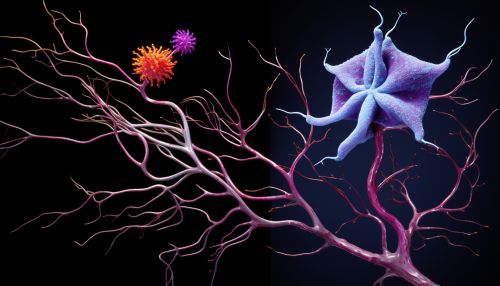Neurodegenerative Diseases
Introduction
Neurodegenerative diseases are a heterogeneous group of disorders characterized by the progressive degeneration of the structure and function of the nervous system. They are incurable and debilitating conditions that cause problems with motor function, mental functioning, and ultimately lead to death. The most common neurodegenerative diseases include Alzheimer's, Parkinson's, Huntington's, and Amyotrophic lateral sclerosis (ALS)[1].


Etiology
The exact cause of neurodegenerative diseases is not completely understood, but it is believed to involve a combination of genetic and environmental factors. Some neurodegenerative diseases, such as Huntington's disease, are caused by a single genetic mutation. Others, like Alzheimer's disease, are thought to be caused by a combination of genetic, lifestyle, and environmental factors[2].
Pathophysiology
Neurodegenerative diseases are characterized by the progressive loss of neurons, which leads to the symptoms of the disease. This neuronal loss is often associated with the accumulation of abnormal proteins in the brain, which can disrupt normal cellular functions and lead to cell death. For example, in Alzheimer's disease, the proteins amyloid-beta and tau accumulate in the brain, forming plaques and tangles that are believed to contribute to the disease process[3].


Clinical Manifestations
The clinical manifestations of neurodegenerative diseases depend on the specific disease and the area of the brain that is affected. However, common symptoms across many neurodegenerative diseases include cognitive decline, motor dysfunction, and behavioral changes. For example, Alzheimer's disease is characterized by memory loss and cognitive decline, while Parkinson's disease is characterized by motor symptoms such as tremors and rigidity[4].
Diagnosis
Diagnosis of neurodegenerative diseases is often challenging, as many of the symptoms can be similar to those of other conditions. Diagnosis is usually based on a combination of clinical history, physical examination, and diagnostic tests such as neuroimaging and laboratory tests. In some cases, a definitive diagnosis can only be made through a brain autopsy after death[5].


Treatment
There is currently no cure for neurodegenerative diseases, and treatment is primarily focused on managing symptoms and improving quality of life. This can involve medications to manage symptoms, physical therapy to improve mobility, and support services to help with daily activities. In some cases, surgical interventions such as deep brain stimulation may be used[6].
Research and Future Directions
Research into neurodegenerative diseases is ongoing, with a focus on understanding the underlying causes of these diseases and developing new treatments. This includes research into the role of genetics, the mechanisms of neuronal death, and the development of new drugs and therapies. There is also a growing interest in the potential role of lifestyle factors and preventative strategies in neurodegenerative diseases[7].


See Also
References
- ↑ https://www.ncbi.nlm.nih.gov/pmc/articles/PMC3291400/
- ↑ https://www.ncbi.nlm.nih.gov/pmc/articles/PMC3139429/
- ↑ https://www.ncbi.nlm.nih.gov/pmc/articles/PMC2841576/
- ↑ https://www.ncbi.nlm.nih.gov/pmc/articles/PMC3170532/
- ↑ https://www.ncbi.nlm.nih.gov/pmc/articles/PMC2929338/
- ↑ https://www.ncbi.nlm.nih.gov/pmc/articles/PMC3002636/
- ↑ https://www.ncbi.nlm.nih.gov/pmc/articles/PMC5573220/
